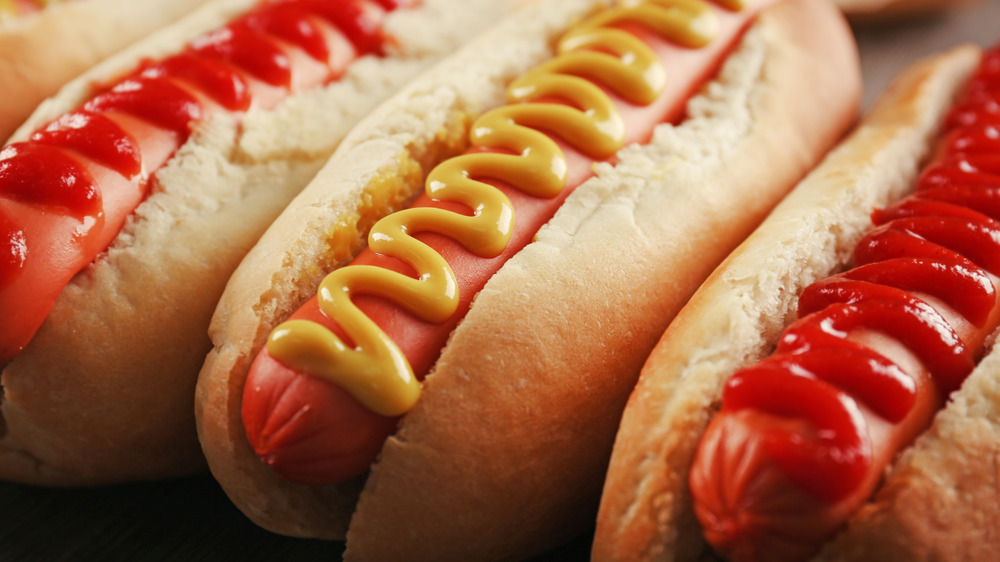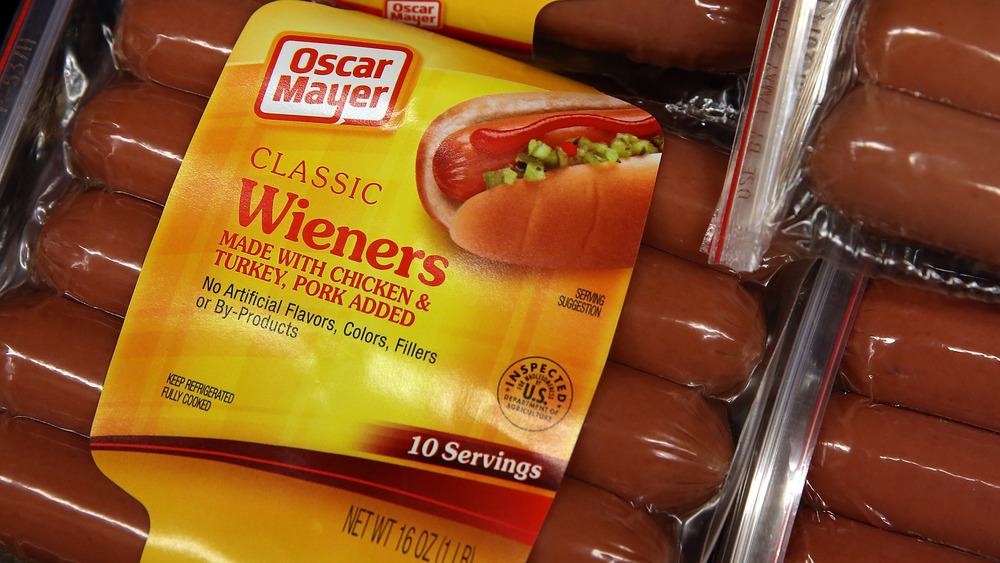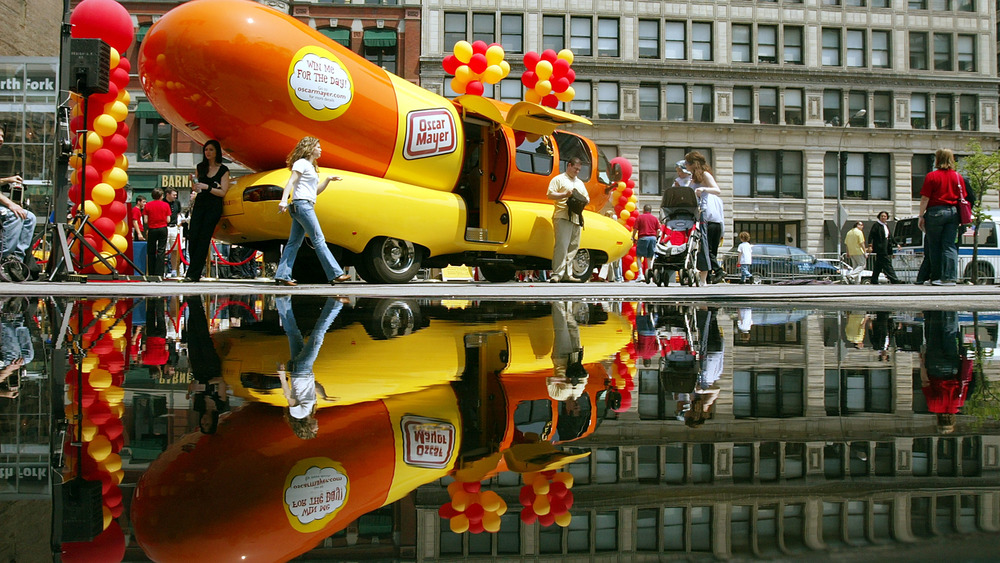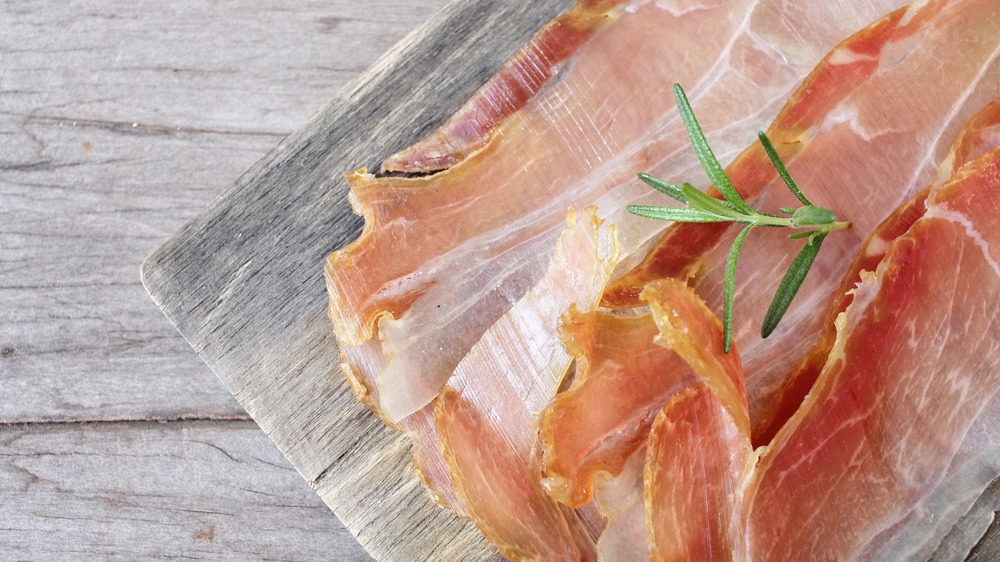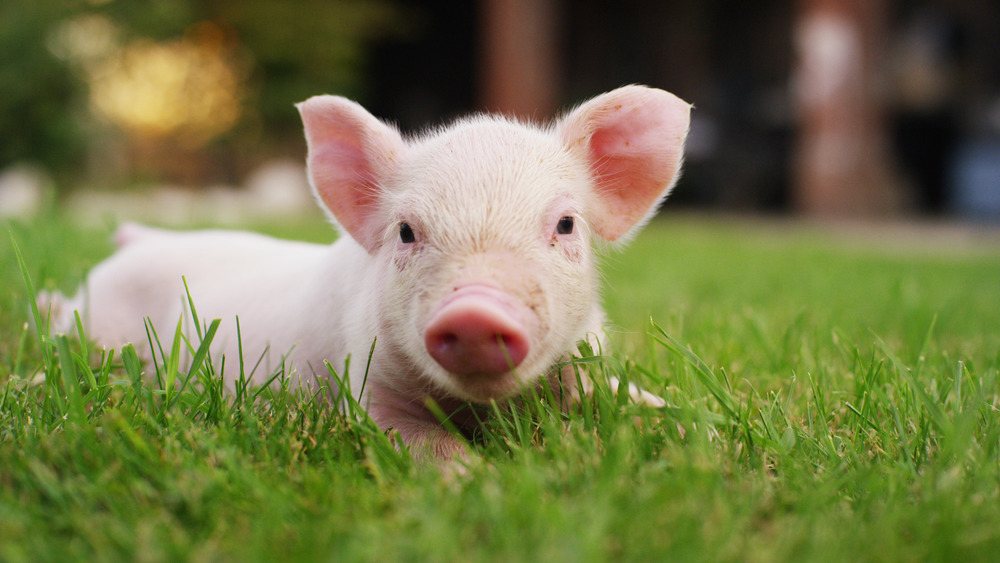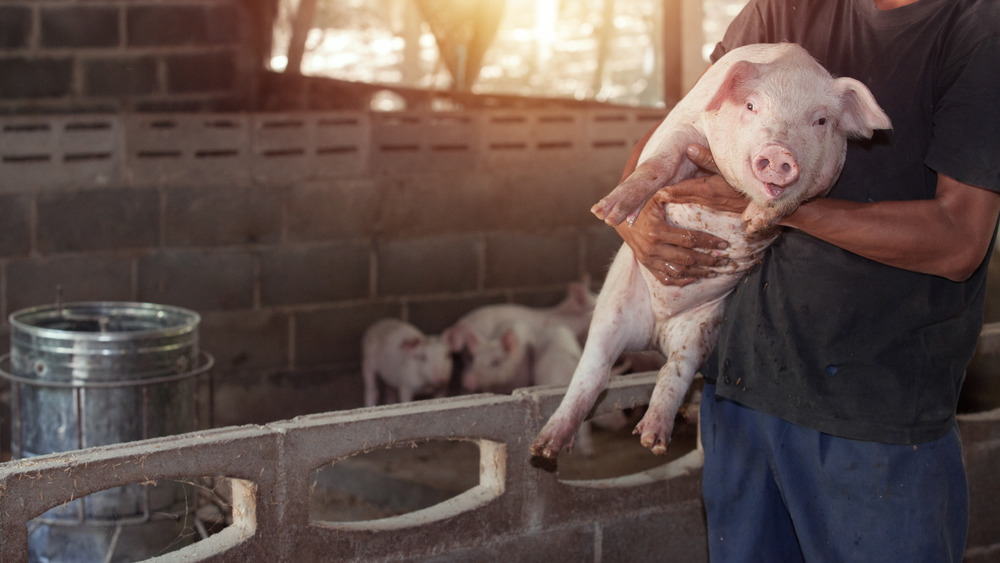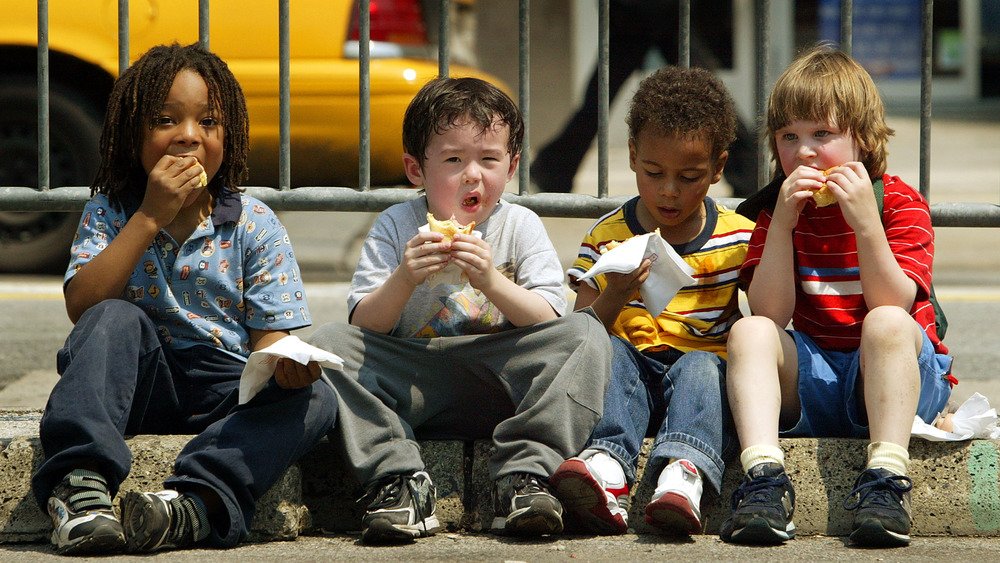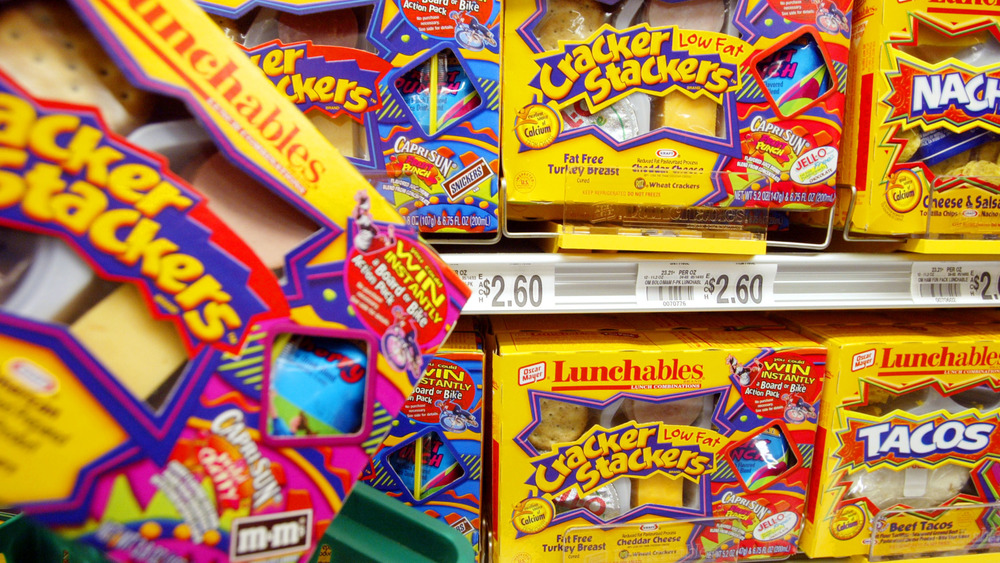The Untold Truth Of Oscar Mayer
You know the jingles, you've filled lunchboxes and sandwiches with their bologna, you've had countless hot dogs from those yellow packages. Some of you — at least, according to The LA Times — even named your children after the curly-haired little cutie in the commercials. But how much do you really know about Oscar Mayer, the company that's supplied America with its processed meats for several generations?
He was a real person
Like Duncan Hines, Oscar Mayer was a real person. He was born in Bavaria in 1859, and emigrated to the US when he was 14. After apprenticing with a butcher and spending another six years working in a meatpacking plant, he had saved enough money to lease the Kolling Meat Market in Chicago. It was about that time his first brother — Gottfried — joined him, and became the business's sausage-maker. Another brother, Max, joined them a few years later, and jumped into the business as an accountant.
They were hugely successful, in part because they had brought traditional European techniques to America, and since Chicago had a growing population of German-American families, their sausages were a little taste of home. By the beginning of the 20th century, they had 43 employees, eight delivery wagons, and supplied nearly 300 stores in Illinois and Wisconsin. Another family member also joined the business in 1909 — Oscar's son, Oscar G. Mayer.
That yellow background harkens back to its original packaging
Oscar Mayer's success is even more impressive if you consider the culinary climate of the day. Upton Sinclair published The Jungle in 1906, a damning looking behind the scenes of the meat packing industry. He wrote about horrors that would turn the stomach of the most dedicated carnivore (you're eating people, people!) and it was understandable the public started looking on the whole industry pretty dubiously. That went double for things like sausages — they were meats that hid their true contents, after all.
Oscar Mayer started advertising the quality of their sausages with a distinctive yellow band, and you can see some of the old advertisements in the Duke University Libraries Digital Collections. It worked, and became such an integral part of the branding it's stayed a part of their look for decades. When Oscar Mayer got a 21st-century update, the creative agency involved, Bulletproof, said the yellow band was such an important part of the Oscar Mayer identity it had to stay.
The Wienermobile used to be a lot smaller
The Wienermobile was the brainchild of Oscar Mayer's nephew, and it's been around since 1936. It's always looked like a giant hot dog, but part of the original concept has fallen to the side of the road.
The Wienermobile was originally manned by a little person hired to dress as chef "Little Oscar" and promote Oscar Mayer products on cross-country road trips. Joe White played Little Oscar for 20 years, and told the LA Times, "My job was to sell wieners. That was my job, and it and the Wienermobile were both a great ride!"
You'd recognize a few of the other men who've donned the guise of Little Oscar over the years, too. Meinhardt Raabe and Jerry Maren both achieved fame as Munchkins from the classic film The Wizard of Oz, and you'd recognize George Molchan, too. He spent 20 years working in the Wienermobile, and another 16 playing Little Oscar at Oscar Mayer's Disney World restaurant. He was the longest-reigning Little Oscar, according to The LA Times, and he passed away in 2005.
They didn't invent bologna, but they made it popular
Oscar Mayer has a ton of products, but the first thing you probably think of is their hot dogs and bologna. According to Eater's history of bologna, this weirdly textured meat was around long before Oscar Mayer.
It has roots in old Italy, where it's been a longtime favorite under another name — mortadella. In 1661, legislation restricted just what could be called mortadella, so sausages that were close but not quite good enough were named for the town instead, and became bologna. It's not clear when it made the trip across the Atlantic, but we do know it was popular during tough times, like the Depression and World War II. It would have been easy for something associated with hardship to fall by the wayside once things improved, but Oscar Mayer kept bologna on everyone's radar with an invention you still use today — their distinctive vacuum-sealed packaging. That made bologna practical as well as popular, because no one likes waste.
They've made a hot dog-carrying drone
The Wienermobile may have been the thing that brought hot dogs to countless 20th-century kids, but now, the idea's gotten an update for the next century. In 2017, Gizmodo reported on Oscar Mayer's new hot dog delivery system — the WienerDrone. The drone has a flight time of only about 15 minutes and can only carry a single hot dog, so it's not very practical for, say, delivering a BBQ's worth of Oscar Mayer hot dogs right to your front door. But coolness is more important than practicality when it comes to advertising, and that's probably why the WienerDrone comes two years after another highly impractical adaptation of the Wienermobile. Gizmodo also covered the release of the WienerRover in 2015, and the remote-controlled, off-road vehicle got such publicity that they introduced a mass-market version not long after.
Their sliced bacon was a first
Oh, bacon. It's one of the oldest methods we've had of preparing meat, and according to The Meat Institute, people have been enjoying salted pork bellies since around 1500 BC. That's a long time to go unchanged, and it wasn't until Oscar Mayer came along that consumers were able to buy bacon in the conveniently packaged, pre-sliced form we know and love today. It might seem obvious to pre-slice bacon now, but the invention was such a big deal they got a US patent for it.
While we're on the tasty subject of bacon, let's talk about that weird packaging. No other meat is packaged the same way, and Bloomberg says that's because the US Department of Agriculture ruled bacon packages needed to be transparent on both sides so consumers could see just how fatty all the slices are. While it was Swanson who patented the shingle-style packaging format, it was Oscar Mayer who patented the front- and rear-window version we see in stores today.
That jingle was written in an hour
In September 1962, songwriter Richard Trentlage heard about a contest Oscar Mayer was holding. Inspired by a comment his son made — he said he wanted to be "a dirt bike hot dog" — Trentlage sat down and wrote the now-famous jingle in about an hour. The Chicago native typed up the lyrics and submitted them, but it wasn't an overnight sensation. In fact, Digital Music News says it almost didn't get selected at all. Oscar Mayer spent a whole year consulting with focus groups and debating about which contest submission was going to be the big winner before settling on Trentlage's catchy tune.
It went on to be one of the longest-running jingles ever, and was only retired in 2010. That's not bad for an advertising tune first recorded in the songwriter's home studio, sung by his 11-year-old son and 9-year-old daughter. Trentlage passed away in 2016, but there's no doubt his song will live forever.
That bologna commercial was a last-minute fluke
You know the bologna commercial, too, with the curly-haired little boy sitting on a pier and fishing while he eats his sandwich and sings about Oscar Mayer. That little boy is Andy Lambros, and he went on to be a web and graphic designer and marketing consultant. He almost didn't get his time on the little screen, though, as that wasn't supposed to be the commercial at all.
According to an interview with Oscar Mayer's Vice President of Marketing Jerry Ringlien, the plan was originally to recruit dozens of kids who would each sing a little bit of the song. The idea was that it would show how everyone loved Oscar Mayer bologna, and that's the commercial they filmed. The film crew had a few minutes of daylight left, though, and asked if there was anyone there who could sing the song from start to finish. Lambros could — and did — and that's why he asks, "How's that?" at the end. When they were reviewing the footage, they knew that was the commercial they needed to use.
They're making a commitment to responsibly-raised pork
One thing everyone can agree on is the importance of responsibly raised animals. In 2012, The Humane Society of the United States gave Oscar Mayer (and parent company Kraft Foods) a shout-out for promising to end the use of gestation crates in their food chain. Gestation crates are highly controversial, and are essentially crates barely larger than a sow. Pigs are forced to live and give birth in crates so tiny they can't even turn around, and according to Oscar Mayer's statement, none of their pork products will be supplied by farmers who use them by 2022.
They helped teach about animal welfare
The meat industry remains one of the most controversial parts of our modern food supply, and in 2014 Oscar Mayer's Animal Welfare Team announced they would be partnering with the University of Wisconsin for a program designed to teach students about animal welfare issues. That's everything from assessing animal husbandry practices to finding sustainable yet safe ways to improve the industry.
The partnership ultimately focused on the creation of several new courses at the university, along with public resources on animal welfare issues. Assistant professor of animal science Kurt Vogel, PhD. was named Oscar Mayer Faculty Scholar, and teaches classes from animal physiology to meat production systems.
There's ongoing debate about the removal of nitrites from hot dogs
There's ongoing concern growing over exactly what our mass-produced, store-bought foods contain, and processed meats is one of the biggest question marks of them all. In May 2017, Oscar Mayer announced they were eliminating "added nitrites, nitrates, artificial preservatives, and fillers" from their hot dogs, according to The Chicago Tribune.
It sounds great on the surface, but there's ongoing debate about just how much of a difference the move is going to make. Without nitrites, those tasty-looking hot dogs would be an unappetizing gray, so that's not an option. Instead, they're going with nitrites extracted from celery. Still sounding good, right?
But nitrites are nitrites, and celery actually has a good percentage of them. In spite of what you may have heard, the federal government doesn't consider nitrites dangerous, and that's a good thing — they're not actually going away anytime soon.
Lunchables are mind-numbing bad for you, and they've always known it
Who doesn't love Lunchable day? They're so much better than a boring old PB&J, right? Way back in 1999, nutritionists were confirming what parents were already suspecting — Lunchables are mind-numbing bad for you. They hit the shelves in 1988, and by 1999 Oscar Mayer had sold 1.6 billion. The Washington Post says was a massive hit for a few reasons: it was convenient for parents and it was convenient for parent company Kraft, who could slip some of their other products — like Capri Sun — into that bright yellow box.
But there are big problems. They're low in fiber, have few vitamins and minerals, and some types come packed with about 50 percent of your child's daily fat intake. In 2009, Lunchables topped the Physicians Committee for Responsible Medicine's Cancer Project list for worst packaged lunchbox meals. We'll just look at the winner — Lunchables Maxed Out Cracker Stackers: Cracker Combo Ham and Cheddar. With 660 calories, 9 grams of saturated fat, and 1,600 milligrams of sodium (which is way more than the daily recommended intake for kids), this is one lunch that's not going to do your kids any favors.
